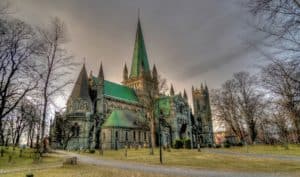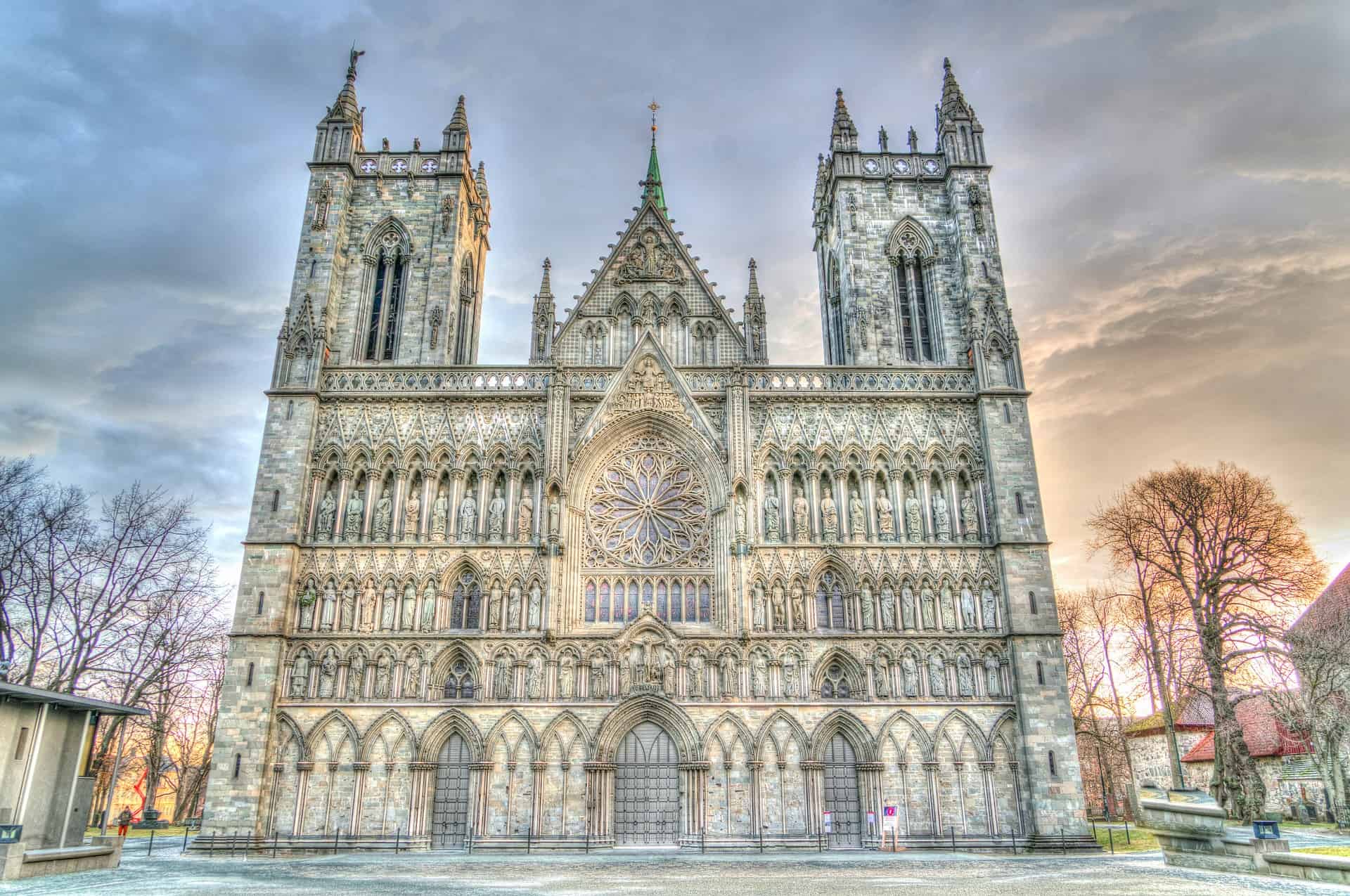The Legendary St. Olaf
Close to Trondheim lies the burial site of the famous St. Olaf, the magnificent Nidaros Cathedral. St. Olaf, also known as Olav Haraldsson , was the king of Norway in the period 1015-1028. St. Olaf led the unification of the country ahead and played a fundamental role in the introduction of Christianity in Norway. He played the greatest importance after his death as a national saint.
He was at odds with many of those who had previously supported him; nobles, peasants and even his own family. This was partly because of his relentless policies in confiscating property and the resolute conduct by the Christianization of the country, converting pagans.
St. Olaf escaped to Sweden after an unsuccessful battle against the danish king. In 1029, St. Olaf glimpsed the opportunity to return as king of Norway. On his journey back to Norway he gathered an army consisting of Swedish, Icelandic and Norwegian followers and fighters. He came over Verdalen in Trondelag and met a peasant militia at Stiklestad, which according to Snorre consisted of more than double the men under the leadership of famous princes and nobles. St. Olav’s army didn’t stand a chance.
The legendary battle of Stiklestad was inevitably soon initiated. This historic battle is one of Norway’s most famous.
Nidaros Cathedral Trondheim
Heimskringla
Heimskringla is the most known of the Old Norse kings’ sagas. It was written on Iceland by the historian and poet Snorri, who had himself visited Norway and Sweden. The manuscripts is a collection of sagas about the history of Norwegian kings. The sources of his work are disputed, but earlier kings’ sagas is included, as well as twelfth century Norwegian oral traditions and synoptic stories, notably alot of skaldic poems.
St. Olaf’s death
According to Snorri St. Olaf was killed by three wounds: He was first carved in the thigh, whereby he threw away his sword. Thereafter, a spear was stabbed in his stomach, until he finally got a cut in the neck on the left side. It was his path.
A church was erected on the spot where St Olaf fell – Stiklestad Church. According to tradition, St. Olaf have relied against a rock when he died. This stone must according to tradition have been bricked into the altar of Stiklestad Church. Olaf The stone was a place of pilgrimage in the Middle Ages, and it was said that it conveyed a divine healing power. It is disputed whether the stone is behind the altar in the church today is the original stone. The body of St. Olaf was short after the battle led to Nidaros. Because of the wonders which allegedly happened after his death was Olaf Haraldsson declared a saint, and carries for the future designation Sankt Olaf, St. Olaf or Olaf the Holy.
St. Olaf’s death represents the introduction of Christianity in Norway.
Olaf Haraldsson’s corpse was embalmed and the mummified corpse was kept in St. Olaf’s shrine in Nidaros Cathedral from around 1090. This was an important Nordic pilgrimage until the Reformation in 1537. The main part of the skeleton is today probably somewhere under the floor of the cathedral.
Think you need Travel Insurance?
In the place where St. Olaf remains lay the first winter it came up a fair source – with water which had healing power. The source was later built into the octagon in Nidaros Cathedral, and pilgrims in their thousands flocked here to drink of the holy water .
It was first set up a small wooden chapel above Olav’s grave, and in 1070 King Olaf Kyrre built a church in stone – it was the beginning of the cathedral we know today. St. Olaf’s reputation as a saint grew quickly, and as Norway’s eternal king – Rex perpetuus Norvegiæ – he was our greatest martyr king, known and grown far beyond its borders. It poured huge amounts of gifts to the church – which made it possible to build the great cathedral.
Glass window at the Nidaros Cathedral
Simple Church to Cathedral
Construction continued after Olaf Kyrre death with reconstruction of a Romanesque central tower and the lower parts of the transept. In 1153 the archdiocese was established in Nidaros, and the cathedral was under the archbishop’s control until its abolition in 1537. This increased urge to build out of St. Olav’s Church in all its glory. The cathedral’s major builder from 1160 was Archbishop Eystein Erlandsson. He built the chapter house and sacristy on the north side of the altar.

Eystein continued work in the transept before he had to flee the country in 1179. During his stay in England the Archbishop got to see the Gothic choir building in the Canterbury Cathedral. He was so excited about the new style that he began to dream of making the the Cathedral of Nidaros to the largest and most powerful in Northern Europe. When he returned to Nidaros in 1183 he immediately started Octagon – the high altar. In 1248 the Archbishop Sigurd Eindrideson built the west nave – and later on the ship was raised in a powerful High Gothic. One assumes that the whole church was finished in its full glory about 1300.
The Nidaros Cathedral
Already in 1328 the first fire hit the church, and since followed two new fires in 1432 and 1531. In 1689 the main tower’s spire blew down a stormy night, and in 1708 and 1719, the church was again hit by fires. The ship was now long in ruin, and was shut down from the rest of the church.
Restoration
A growing national awareness gradually raised demands for the reconstruction of the cathedral to the medieval grandeur. Therefore, a separate building cottage, Nidaros Cathedral Restoration Workshop established in 1869.. The task was given to architect HE Schirmer. In the period 1869-1873 he led the restoration of the chapter house. There was criticism against Schirmer, because he took care of great artistic freedoms in the restoration work. In 1872 the architect Christian Christie took over the work. He used archaeological material to uncover all aspects of church history before he began work on the chancel, tower and transept.
It was later decided to restore the ship and the western front. From 1908, this work led by architect Olaf Nordhagen. For the most part it worked there 90 man doing the restoration work, with 50 stonemasons. The ship was finished in 1930, but after his proposal for the design of the western front, the architect Helge Thiis continued the work from 1928. The Western Front with the two west towers were substantially completed in 1965, but only in 2001 was the restoration work officially completed. Replacing the bad stones and reinforcement of weak points is continued however.
The Nidaros Cathedral-Trondheim
Tourism
The cathedral served as the most important pilgrimage site in Northern Europe Middle Ages. Also today, the cathedral is a popular tourist attraction. Tourists often follow the historical pilgrim routes to visit the spectacular church. Nidaros Cathedral is the site of the observation of St. Olav’s Wake. This religious and cultural festival is centered upon the anniversary of the death of St Olav. Tourists often follow the historic Pilgrim’s Route to visit the cathedral for this and other events.
Click for Webcam in Trondheim
If you need a place to stay during your visit: Hotels in Trondheim
 
[wpgmza id=”25″]
